Department of Prosthetic Dental Sciences, College of Dentistry, King Saud University, Riyadh, Saudi Arabia
Corresponding author email: labbanny@yahoo.com
Article Publishing History
Received: 15/10/2019
Accepted After Revision: 01/12/2019
To assess the influence of four maxillary anterior teeth-related variables on the smile attractiveness in Saudi population. Two standardized frontal smile photographs with skin color type III (Fitzpatrick scale) & tooth shade BL2 for male and female subjects were used to alter four different variables (lateral incisors length, central incisors angles, length of interproximal contact area and prominence of central incisors). An electronically displayed questionnaire was used to assess the demographic characteristics of subjects along with the satisfaction of their smiles. Each variable had a set of three digitally altered images in which the participant should select the most attractive one. Cross-tabulations and chi-squared tests were used to perform the statistical analyses (α = 0.05). 843 subjects were enrolled in the study. The median (IQR) score of importance of smile and level of satisfaction of smile among the study subjects were 9(3) and 7(3) respectively. The comparison of mean rank score of importance of smile, in relation to the age groups, gender and educational level showed statistically significant difference. Mean rank values of level of satisfaction of smile in relation to age groups, gender and educational level were comparable. Most of the Saudi populace preferred 1mm incisal length difference in females and equal incisal length in males, with round incisal angles for both males and females. The ideal interproximal contact area of 50:40:30 proportion was considered as most attractive and almost half of the included Saudi population preferred the prominent central incisor
Aesthetics; Smiling; Maxillary Anterior; Saudi Populace; Incisal ang
Labban N, Alrabiah M, Alamri W, Fakeeha G, Almutairi O, Alotaibi H. Influence of Maxillary Incisor Variables on Smile Attractiveness Perception of Saudi Population. Biosc.Biotech.Res.Comm. 2019;12(4).
Labban N, Alrabiah M, Alamri W, Fakeeha G, Almutairi O, Alotaibi H. Influence of Maxillary Incisor Variables on Smile Attractiveness Perception of Saudi Population. Biosc.Biotech.Res.Comm. 2019;12(4). Available from: https://bit.ly/2rKnRvJ
Copyright © Labban et al., This is an open access article distributed under the terms of the Creative Commons Attribution License (CC-BY) https://creativecommns.org/licenses/by/4.0/, which permits unrestricted use distribution and reproduction in any medium, provide the original author and source are credited.
INTRODUCTION
The analysis of the dental esthetic and assessment of various elements that contribute in the production of a pleasing and attractive smile are a major concern for dental practitioners (Niaz et al., 2015). Patients in contemporary dentistry are increasingly concerned with the esthetic of the restoration and their satisfaction is primarily based on the definitive appearance of the dentofacial structures (Exley, 2009). When it comes to dental esthetics, to achieve an excellent result, it is mandatory to provide an interdisciplinary treatment for patients (Rosa and Zachrisson, 2007). Esthetic analysis and planning are of critical importance to achieve patient expectations when providing any esthetic dental treatment. Multiple dental and dento- gingival variables contribute towards achieving an attractive smile ( Sepolia et al., 2014 Parrini et al., 2016).These vital elements can be divided into two different categories. The first one includes tooth-related components including, dental midline, incisal length, tooth dimension, zenith point, axial inclination, interdental contact area, incisal embrasure, symmetry, and balance (Ito et al., 2006). The second category includes soft-tissue related components such as, gingival health, gingival harmony and levels, interdental embrasure, and smile line (Bhuvaneswaran, 2010, Taki et al., 2017).
Recently, relationship between perception of smile esthetics and orthodontic treatment in Spanish patients has been reported by Colvee et al. (2018), where patients presented significant differences in the esthetic perception of midline diastema and gummy smile anomalies after they had completed orthodontic treatment. Gender influenced the perception of smile esthetics, whereby women were significantly more critical of midline diastema, black triangle and gingival margin of the upper central incisor than men. The age variable also showed significant differences in the perception of midline diastema and black triangle anomalies. The perception of smile esthetics of some dental anomalies changes as a result of orthodontic treatment. Gender influences the perception of some of the dental anomalies studied, (Colvee et al. 2018).
According to literature, features related to maxillary central incisor, forms the foundation to achieve excellent results when designing a smile (Rosenstiel et al., 2000). “The dominance of central incisors” is a term that has been used widely in literature to highlight the significance of central incisors and to refer them as the protagonists of smile (Machado et al., 2013). However, with increasing age patients tend to develop a reverse smile as a result of incisal attrition losing the incisal edge position of maxillary anterior teeth (Saffarpour et al., 2016). Anderson et al., (2005) in a study concluded that the shape of the canine was less important than the shape of central and lateral incisors in the esthetics of anterior teeth. In addition, it is reported that round shaped incisors (i.e., round outline form of the tooth) were more esthetically pleasing than their square counterpart. Furthermore, an enlarged gingival embrasure called.
“black triangle” cervical to the contact point of incisal teeth is of great significance, affecting the perception of patients on smile (Sudhakar and Vishwanath, 2014, Al Taki et al 2017 Geevarghese et al., 2019). The criteria by which individuals perceive and define beauty differs based on multiple factors including social characteristics and profession of an individual (Al Taki et al., 2017). A study by Labban et al., (2017) previously investigated the influence of gender and skin color on the preference of tooth shade in Saudi population. However, there is limited evidence on the effect of maxillary incisor variables on the perception of different smiles in Saudi population. In the present study, it is hypothesized that there is no difference in the perception of different smiles when changing the maxillary incisors related variables. Therefore, the aim was to assess the Saudi population perception of different smiles by altering the variables of maxillary lateral incisors vertical position, shape of the mesial and distal angles, interproximal contacts, and the prominence of central incisors (i.e., wider tooth width resulting in greater percentage of anterior width).
MATERIALS AND METHODS
Preparation of photographs
The study protocol was approved by the Institutional Review Board (IRB) & the College of Dentistry Research Centre (CDRC). Twenty-Two digital photographs for two adult subjects (male & female) were used in the present study. Photographs showed the frontal smile alone, excluding other facial structures to avoid any distracting variables. Skin color type III (Fitzpatrick scale) & tooth shade BL2 (A-D shade guide 2016 Ivoclar Vivadent Inc., USA) was used based on the results of our previous study (Labban et al., 2017). The teeth shape parameters in the photographs were digitally altered by Adobe Photoshop software (Adobe Systems CS6, Ireland Ltd).The photographs were grouped into four sets for both male and female, each representing an altered maxillary incisor related variable as follows: (1) Crown length of the lateral incisors, (2) The shape of the maxillary central Incisor angles, (3) Length of interproximal contact area, (4) Prominence of central incisors
Crown length of the lateral incisors
The Incisal edge of the lateral incisor was altered by 1 mm increments to produce three images: 0 mm, 1 mm, 2 mm shorter than the adjacent central incisor (Fig. 1)
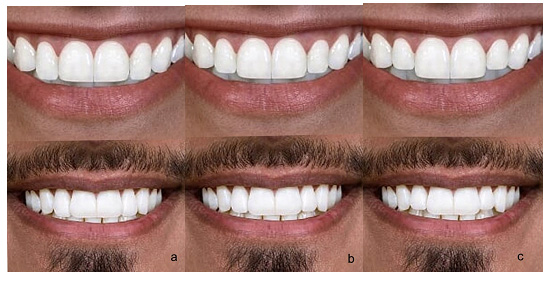
The shape of the maxillary central Incisor angles
Mesial and distal angle was altered to produce three images: square, square-round, and round (Fig. 2)
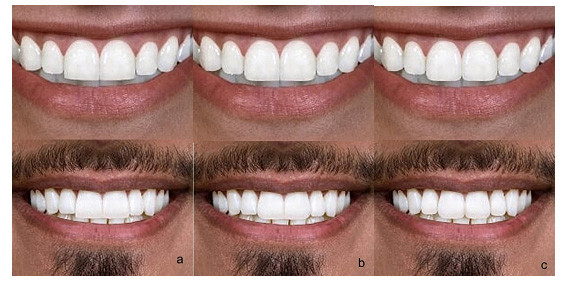
Length of interproximal contact area
The length of the maxillary centrals was measured using a tool in Photoshop software, and divided into a nominal 100 units. This calibration was used to modify the interproximal contacts area between the maxillary anterior teeth with different ratios. The three pictures investigated were as follow: The ‘Ideal’ image giving a ratio of 50:40:30. The “Equal” image interproximal contact areas as arranged in a 50:50:50 ratio. The “Reversed” image demonstrates the inter-proximal contact areas as arranged in a 30:40:50 ratio. (Fig. 3)
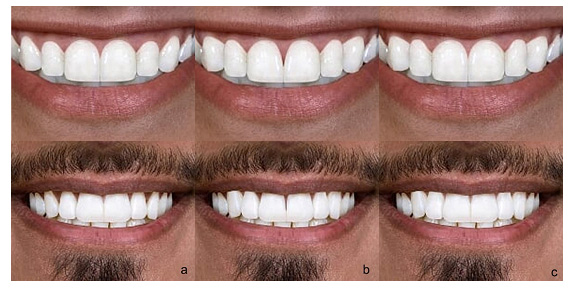
Prominence of central incisors “Altered Smile”
Two maxillary central incisor images were manipulated in both width and length. As for the length, the central incisors were elongated by 0.5 mm in both male and female. As for the width, the central incisors were manipulated in a way to give an illusion that was more prominent than the adjacent lateral incisors. (Fig. 4)

Questionnaire distribution and data collection
Consent was obtained from each participant prior to their enrolment in the survey. The subjects were randomly selected from shopping malls and public areas. Exclusion criteria included dentists and children. The questionnaire was electronically displayed to the subjects on a tablet device (Apple iPad pro tablet, Apple Inc.). The questionnaire included item to assess demographic characteristics such as age, nationality, gender, educations level, occupation, and income. The subjects were asked to report level of satisfaction of their smiles on a scale from 0 to 10 (0, not satisfied and 10, very satisfied). Applicants were also asked to indicate the importance of a smile using the same scale (0, not important and 10, very important). Sets of male and female pictures were displayed to the subjects and they were asked to select the most esthetically pleasing smile regarding gender and teeth shape. Therefore, each participant was asked to prefer a total of 8 images from the total of 22 different images showed and asked to describe the characteristics from these images
Statistical analysis: Data were analyzed using SPSS (version 21, SPSS Inc., Chicago, IBM, USA) statistical software. Descriptive statistics (median, inter quartile range, frequencies, and percentages) were used to describe the skewed quantitative and categorical variables. Mann-Whitney U-test and Kruskal Wallis test were used to compare the mean rank values of importance of smile and satisfaction level in relation to the categorical variables of two and more than two categories. Pearson’s Chi-square test was used to observe the association between the categorical variables. A significance level of 0.05 was used to report the statistical significance of results.
RESULTS AND DISCUSSION
Out of 843 subjects in the present study, 488 (57.9%) were in age range between 20 to 30 years. Majority of the respondents (80.7%) were females. Bachelor level of education was found in 704 (83.5%) subjects. 679 (80.5%) respondents were unemployed and the monthly income of >15000 SR was found in only 17.3% subjects (Table 1).
Table 1: Distribution of socio-demographic characteristics of study participant (n=843)

Subjects’ preference for these characteristics towards four male and female pictures which displayed different variables (incisal length, incisal angel, interproximal contacts areas and prominence of centrals) are given in table 2. The median (inter quartile range) score of importance of smile and level of satisfaction of smile among the study subjects was 9(3) and 7(3) respectively. (Table 2).
Table 2: Subject preference of esthetically pleasing smile descriptive statistics of importance, level of satisfaction of smile
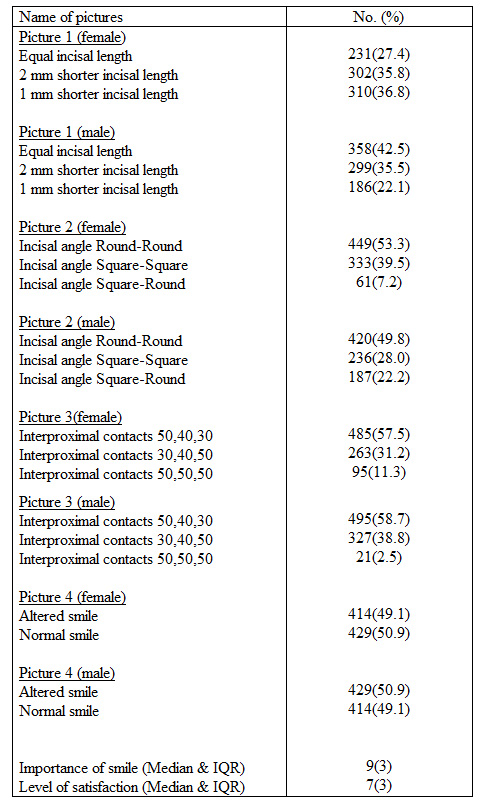
Considering gender, higher proportion of males (52.8%) preferred 1mm shorter lateral incisor length of female picture, while (43.6%) of male preferred 1mm shorter lateral incisor length of male picture. Similarly, in female and male pictures of interproximal contacts, 42.9% male preferred interproximal contact ratio of 50:40:30 in female picture. Whereas, 61% of female preferred interproximal contacts 50:40:30 in female picture. This comparison was found to be statistically significant. Furthermore, statistically significant association was found between the preferences of two categories of prominent centrals in the male picture, in which 43.6% & 56.4% of male had preferred altered and non-altered smile respectively.
When education level of subjects was compared to different study variables. It was observed that those who had bachelor’s degree had skewed views regarding the length and shape of lateral incisors both for male and female smiles. Whereas, subjects with a higher degree (100%) preferred 1 mm shorter lateral incisor length both in male and female images. Among the respondents who studied till secondary school, a majority preferred the picture of interproximal contacts 30:40:50 in female smiles and interproximal contacts 50:50:50 in male smiles. Whereas, most of the respondents with bachelor’s degree, opted for 50:40:30 both in male and female picture. Majority of subjects (95.5%) having education level till school preferred non- altered smile both for males and females. In addition, majority of subjects having bachelors level education, chose rabbit smile for both genders. All subjects with higher level of education preferred non-altered smile in both female and male smile.
Table 3: Comparison of mean ranks of (i) importance of smile (ii) satisfaction level of smile scores in relation to socio-demographic characteristics of study subjects
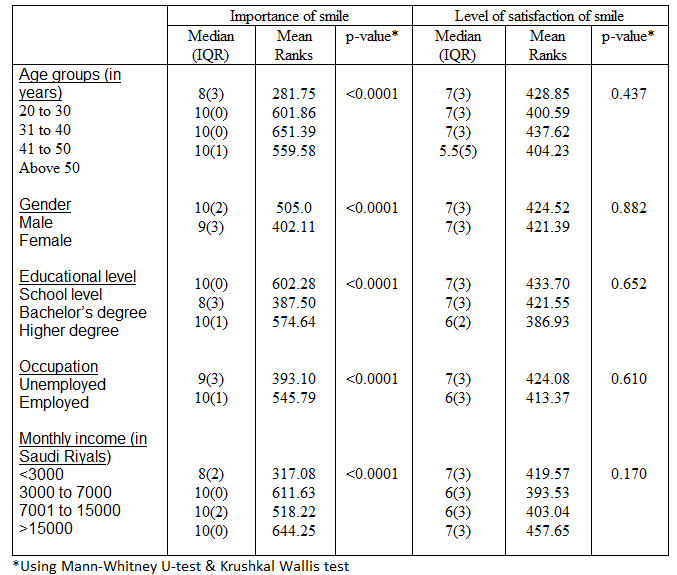
Esthetic dentistry is understood as a general approach to enhance the standards of beauty alongside the optimal health and function of the oral cavity. The present study was based on the hypothesis that there is no significant difference in the perception of different smiles when changing the maxillary incisors related variables. Interestingly, the hypothesis was rejected as changing maxillary incisors variables altered the perception of different smiles. This type of survey was distinctive, as to our knowledge this is the first study of its kind to be conducted in Saudi Arabia.An ideal step between the central and lateral maxillary incisors range between 1 to 1.5 mm for females and 0.5 to 1 mm for males. This indicates that convex smile arcs are more esthetically pleasing for females and convex to plane arcs are more esthetically pleasing on males (Machado et al., 2013).
The results of this current study revealed that a majority (52%) of Saudi male subjects preferred 1 mm step for females. Almost 38% of the Saudi female subjects preferred 2 mm step for females and 45% preferred equal incisal length for males. The overall population’s perception regarding the difference in the incisal length between the central and lateral incisor show that most of the population prefer 1mm difference for females and equal incisal length for males. A similar study by Taki et al., (2017) showed results which were in contrast to the present study. The results by Taki et al, (2017) displayed no significant difference according to gender in the preferred length of lateral incisor. An incisal difference of 0.5 mm was preferred by general populace both in males and females in their study ( Taki et al., 2017).
When the opinions of all subjects were viewed collectively, regarding their preference of the shape of the central and lateral incisors, most of the subjects chose round angles for both males and females. In a similar study Anderson et al., (2005) aimed to evaluate the contribution of the maxillary incisors’ shape on smile esthetics. The study concluded that the round shape of the mesial and distal angles was preferred on female subjects by general practitioners and orthodontists while for common population, there was no preference. In contrast, the square to square- round angles were favored esthetically on males by all orthodontists, general practitioners and lay-people. A disparity regarding perception in shape of lateral and central incisor among females exists within the results of present study and the study by (Anderson et al., 2005).
When considering the effect of the interproximal contact area between the central incisor, lateral incisor and canine, a previous study by Foulger et al., (2010) concluded that ‘equal’ (50:50:50) interproximal contact area arrangement is deemed as most attractive.16 This is in contrast to the ideal 50:40:30 ratio proposed by Sudhakar and Vishwanath, (2014) Conversely, an interproximal contact area arrangement resulting in the presence of a ‘black triangle’ was deemed least attractive. Comparing the results of study by Foulger et al., (2010) to the present study that focused on the Saudi population perception, it was noticed that the majority of the population preferred the ideal 50:40:30 proportion for both males and females. However, it was also observed that subjects with higher degree (educational level) and subjects above the age of 40 preferred the equal interproximal contact with the ratio of 50:50:50 for females and the reversed interproximal contact arrangement with the ratio of 30:40:50 for males.
A recent emerging tendency in which individuals prefer having a prominent maxillary central incisor tooth, is now considered as a new criterion in dental esthetics. It is noticed that large number of patients attending dental clinics seek such profile. This variable has not been mentioned nor studied in the literature before, specifically in Saudi population. Furthermore, it has not been evaluated as previous mentioned criteria on how it affects and determine one’s smile esthetics’ and attractiveness. The results of the present study revealed that almost half of the Saudi population preferred the “altered smile” on both male and female subjects, which indicates high acceptance level of this trend as new criteria of achieving optimal dental esthetics. It was also noted that the male and female subjects who preferred the “altered smile” look, were mostly in the age group of 20-30 with the percentage of 81% and 84% in male and female subjects respectively. While most of the participants who were in the age group of 31- 40 and above, preferred the normal central incisors profile.
In summary, our results demonstrate that whilst there is broad agreement amongst the groups in terms of what constitutes optimal esthetics, differences exist and unless communication is effective, individual pre-conceptions may compromise the patient’s acceptance of the result. In addition, based on the findings and limitations the authors recommend that a comparative study with people of different cultural backgrounds can contribute immensely in understanding variables that may influence an ideal smile. Moreover, since majority of this sample was in the twenty to thirty-year age range, over 80 percent were female, and two-thirds have a monthly income in the lowest income category these demographics might have an influence on the generalization of results. Hence, future studies with increase sample size and diverse demographic characteristics are recommended.
CONCLUSION
It is concluded that variations in the length, shape and prominence of maxillary anterior teeth, particularly the central and lateral incisors, can influence people’s perception of the overall smile attractiveness. Gender, age group, educational background can influence one’s judgment and opinion regarding the standards of beauty and attractiveness.
Funding
Deanship of Scientific Research at King Saud University, Saudi Arabia, for funding this research project (#IR 0252)
REFERENCES
Al Taki, A., Hayder Mohammed, T., Mohammad Hamdan, A., (2017). Influence of the Smile Line on Smile Attractiveness in Short and Long Face Individuals. Int. J. Dent. 2017, 2637148.
Anderson, K.M., Behrents, R.G., McKinney, T., Buschang, P.H., (2005). Tooth shape preferences in an esthetic smile. Am. J. Orthod. Dentofac. Orthop. 128, 458–465.
Bhuvaneswaran, M., (2010) Principles of smile design. J. Conserv. Dent. 13, 225.
Colvee, BB, Beatriz Tarazona ,Vanessa Paredes-Gallardo,Santiago Arias-De Luxan (2018) Relationship between perception of smile esthetics and orthodontic treatment in Spanish patients, PLOS One 13(8): e0201102. https://doi.org/10.1371/
Exley, C., (2009). Bridging a gap: The (lack of a) sociology of oral health and healthcare. Sociol. Heal. Illn.
Foulger, T.E., Tredwin, C.J., Gill, D.S., Moles, D.R., (2010). The influence of varying maxillary incisal edge embrasure space and interproximal contact area dimensions on perceived smile aesthetics. Br. Dent. J. 209.
Geevarghese, Amrita , Jagan Kumar Baskaradoss, Mohammed Alsalem, Abdulelah Aldahash, Waleed Alfayez, (2019) Perception of general dentists and laypersons towards altered smile aesthetics Journal of Orthodontic Science, Volume : 8 Issue 1 Page : 14
Ito, T.A., Chiao, K.W., Devine, P.G., Lorig, T.S., Cacioppo, J.T., (2006). The influence of facial feedback on race bias. Psychol. Sci. 17, 256–261.
Labban, N., Al-Otaibi, H., Alayed, A., Alshankiti, K., Al-Enizy, M.A., (2017). Assessment of the influence of gender and skin color on the preference of tooth shade in Saudi population. Saudi Dent. J. 29, 102–110.
Machado, A.W., McComb, R.W., Moon, W., Gandini, L.G., (2013). Influence of the vertical position of maxillary central incisors on the perception of smile esthetics among orthodontists and laypersons. J. Esthet. Restor. Dent. 25, 392–401.
Niaz, M.O. mar, Naseem, M., Elcock, C., (2015). Ethnicity and perception of dental shade esthetics. Int. J. Esthet. Dent. 10, 286–298.
Parrini, S., Rossini, G., Castroflorio, T., Fortini, A., Deregibus, A., Debernardi, C., (2016). Laypeople’s perceptions of frontal smile esthetics: A systematic review. Am. J. Orthod. Dentofac. Orthop. 150, 740–750.
Rosa, M., Zachrisson, B.U., (2007). Integrating space closure and esthetic dentistry in patients with missing maxillary lateral incisors. Further improvements. Ortod. Clin. 10, 231–232.
Rosenstiel, S.F., Ward, D.H., Rashid, R.G., (2000). Dentists’ preferences of anterior tooth proportion – A web-based study. J. Prosthodont. 9, 123–136.
Saffarpour, Aida, Ghavam, M., Saffarpour, Anna, Dayani, R., Fard, M.J.K., (2016) Perception of Laypeople and Dental Professionals of Smile Esthetics. J. Dent. (Tehran). 13, 85–91.
Sepolia, S., Sepolia, G., Kaur, R., Gautam, D., Jindal, V., Gupta, S., (2014). Visibility of gingiva-An important determinant for an esthetic smile. J. Indian Soc. Periodontol. 18, 488–492.
Sudhakar, D.N., Vishwanath, D.A., (2014). Smile Esthetics – A Literature Review. IOSR J. Dent. Med. Sci. 13, 32–36.
Taki, A. Al, Hamdan, A.M., Mustafa, Z., Hassan, M., Abu-Alhuda, S., (2017). Smile esthetics: Impact of variations in the vertical and horizontal dimensions of the maxillary lateral incisors. Eur. J. Dent. 11, 514–520.


